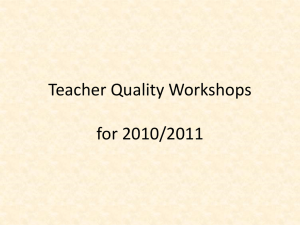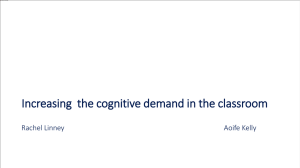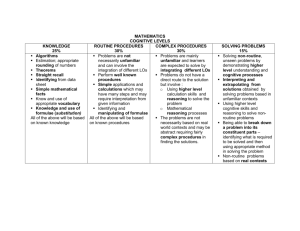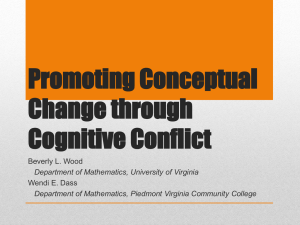Paper of Meir Ben-Hur
advertisement
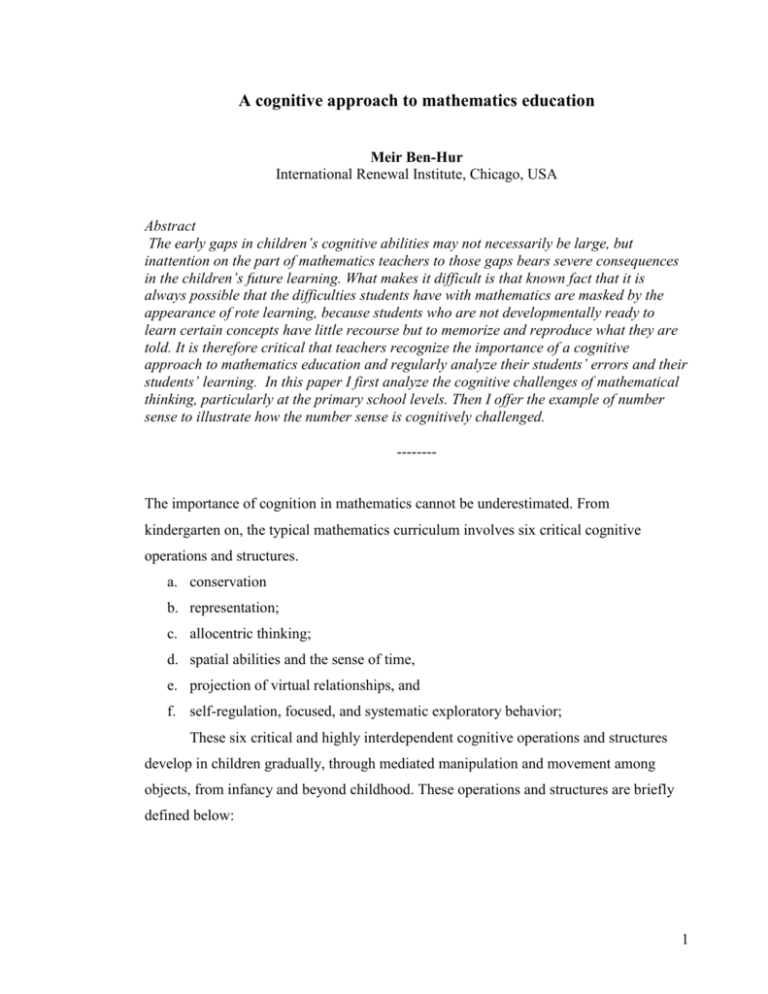
A cognitive approach to mathematics education Meir Ben-Hur International Renewal Institute, Chicago, USA Abstract The early gaps in children’s cognitive abilities may not necessarily be large, but inattention on the part of mathematics teachers to those gaps bears severe consequences in the children’s future learning. What makes it difficult is that known fact that it is always possible that the difficulties students have with mathematics are masked by the appearance of rote learning, because students who are not developmentally ready to learn certain concepts have little recourse but to memorize and reproduce what they are told. It is therefore critical that teachers recognize the importance of a cognitive approach to mathematics education and regularly analyze their students’ errors and their students’ learning. In this paper I first analyze the cognitive challenges of mathematical thinking, particularly at the primary school levels. Then I offer the example of number sense to illustrate how the number sense is cognitively challenged. -------- The importance of cognition in mathematics cannot be underestimated. From kindergarten on, the typical mathematics curriculum involves six critical cognitive operations and structures. a. conservation b. representation; c. allocentric thinking; d. spatial abilities and the sense of time, e. projection of virtual relationships, and f. self-regulation, focused, and systematic exploratory behavior; These six critical and highly interdependent cognitive operations and structures develop in children gradually, through mediated manipulation and movement among objects, from infancy and beyond childhood. These operations and structures are briefly defined below: 1 Conservation Conservation refers to the cognitive ability to judge changes through logical deduction rather by appearance1. It is manifested in the conception of number that is flexible enough to include all the possible variations of what is countable, how it is arranged, and how it is counted: “all fours are 4”. This concept of numbers is involved not only in quantifying objects, but also in equating different denominations of money, measurement, and time. Another example of conservation involves naming geometrical forms, and understanding “volume” without association to shape. Conservation and, eventually, the related schema of transformation lay the foundation of all the reversible operations of mathematics. Representation Conservation cannot exist without representation. The cognitive tools of representation include beside visualization, also language, concepts, and symbols. Thus, representation frees our thinking about objects from our perception. What Numeration involves symbols; geometry involves language and icons etc. Furthermore, representation permits the thinker to discriminate input information, manipulate symbols rather than reality itself, and communicate. Allocentric (non-egocentric) thinking Alocentric- thinking is manifest in the ability to differentiate between self and the world to represent the world from different points of view. It permits us to relate objects in time and space using an objective frame of reference. In fact it allows us to think mathematically, because mathematical thinking is essentially allocentric. Terms such as “more”, “less” etc., are truly relative only when they are conceived of objectively. Clearly, allocentric thinking is a necessary condition for conservation. Spatial and temporal sense The sense of space and the sense of time depend upon conservation, representation, and allocentric thinking. Young children first make sense only of the topological properties in 1 Cockcroft, K., Hook, D. & Watts, J. (2002). Developmental Psychology. UCT Press: Cape Town. 2 space (enclosure, inside space, outside space, and proximity)2. Later they start to develop the Euclidean sense of space as they use allocentrical terms of relative size to describe the relationships among. Only at the end of this developmental journey (normally around the second and fourth grade) children can preserve the properties of distance, angles, and straight parallel vertical, horizontal and diagonal lines3. Children’s early concept of time is normally confused with space. They do not attribute the longer distance accomplished by moving objects to high velocity, but to longer time of the movement, and they understand “old” as synonymous with “big”. For them time is discontinuous and not uniform (this is why in their minds adults stop aging). Projection of virtual relationships The relationships between units and groups and the basic operations with numbers are fundamental in early mathematical thinking. Where these relationships are projected, particularly without manipulating objects, they can be referred to as virtual. Comparing and projecting such relationships are perhaps the most critical consequences of allocentric thought. For example: a math problem may state that Don is 3 years older than Elsa, or that Jamal is younger than Jo by 4 years. Before a child can determine which numbers to add the child must understand these relationships. Projecting virtual relationships permits the child to prioritize, sequence, and identify patterns Self-regulation (cognitive, behavioral and emotional) Mathematical thinking, particularly as in problem solving, requires the ability to set goals for the relatively long- and short-term, prioritize them, and estimate which would be easy and which would be difficult to attain, and monitor and regulate progress. The quality of such self-regulation is increasingly challenged by the mathematics curriculum. It is now appropriate to consider for example the case of the development of children’s sense of natural numbers. The topological space can be thought of as a model of the environment constructed on a rubber sheet. As the sheet is stretched in different directions, the relative distances and directions between locations may change, but the basic layout and the sequence of places along a route are preserved intact. 2 3 Piaget, J., & Inhelder, B. (1948) Op. Cit. 3 Children’s Sense of Natural Numbers Normally, children younger than 5 years tend to confuse the quantity of objects with the amount of space these objects occupy. For example, they would point to a longer pattern as the one with more objects even if it contains the lesser amount. This naive sense of quantities changes as children learn to count using numbers. Numbers have two attributes, ordinality and cardinality. Ordinality refers to the ordered set of numerical terms (“one”, “two”, “three”…). Cardinality refers to quantity the number represents. The following table defines five principles that children must learn to construct the mathematical number sense: The five principles of counting, their learning significance and cognitive challenge 4 Principles of counting: Significance Cognitive challenge Ordinal principle I: Stable and complete order of numeration (e.g., “twelve”, “thirteen”, “fourteen”, etc…) The language of a numeration determines how well children understand the base structure, place value (units, tens, etc.), and later also arithmetical operations. Cultural (language) differences in numeration systems correlate positively with the types of errors made by 3 and 4 year old children5. These differences impact children’s ability to count, their memory span, and eventually their cognitive representation of numbers. Ordinal principle II: One-to-one correspondence between a number and an item to be counted. The analysis/categorisation of sequence facilitates the coordination of the concept of number with the concept of groups. Besides verbal fluency (automaticity), and memory, counting requires coordination that preschool-children may still be lacking even when they understand the concepts involved6. Cardinal principle I: The last count represents the whole. Counting is the trivial of addition (+1). The emphasis is on the need to ensure that the whole group is counted, each member only once: A need for precision. Cardinal principle II: Any order of counting results in the same The emphasis on the flexible concept of group. This flexibility The flexible mechanics of counting requires systematic and organized 4 Adapted from Ben-Hur, M. (2004). Forming Early Concepts of Mathematics. IRI Inc. Glencoe, IL 5 Miura, I. T., Okamoto, Y.,Kim, C. C., Stere, & Fayol. M., (1993). First graders’ cognitive representation of number and understanding of place value: Cross-national comparisons: France, Japan, Korea, Sweden, and the US. Journal of Educational Psychology, 85, 24-30. 6 For example: Gleman, R., a& Meckin, S. (1983). Preschoolers’ counting: Principles before skill. Cognition, 13, 343-359. 4 number forms the foundation for the two basic properties (for addition and multiplication) the associativity and commutativity input. It requires conservation of a constancy (number) over changes (in the configuration of the group) The abstraction principle: Any kind, or mixed kinds of objects can be grouped and counted Numbers are conceptualized as versatile tools for problem solving Numbers are projects of virtual relationships Counting helps children explore the relationships between numbers and establish the basis the arithmetical operations. Learning to categorize what has been counted vs. what is yet to be counted, teaches children to coordinate their perception and their actions. Understanding that the strategy they choose for counting does not affect the result helps them reinforce their conservation schema and enables them to develop the intuition for the associative and commutative properties of the two basic operations (addition and multiplication). Ultimately, counting becomes a useful tool they learn for solving problems. A cognitive approach to teaching mathematics requires that teachers not only know the instructional challenges, but also that they know how to mediate them. For this reason it is important that teachers of mathematics study the work of Reuven Feuerstein, and the example of Feuerstein’s Instrumental Enrichment. This work provides effective strategies and a particular program that are aimed exactly at the development of these critical cognitive challenges. meirbh@aol.com 5



